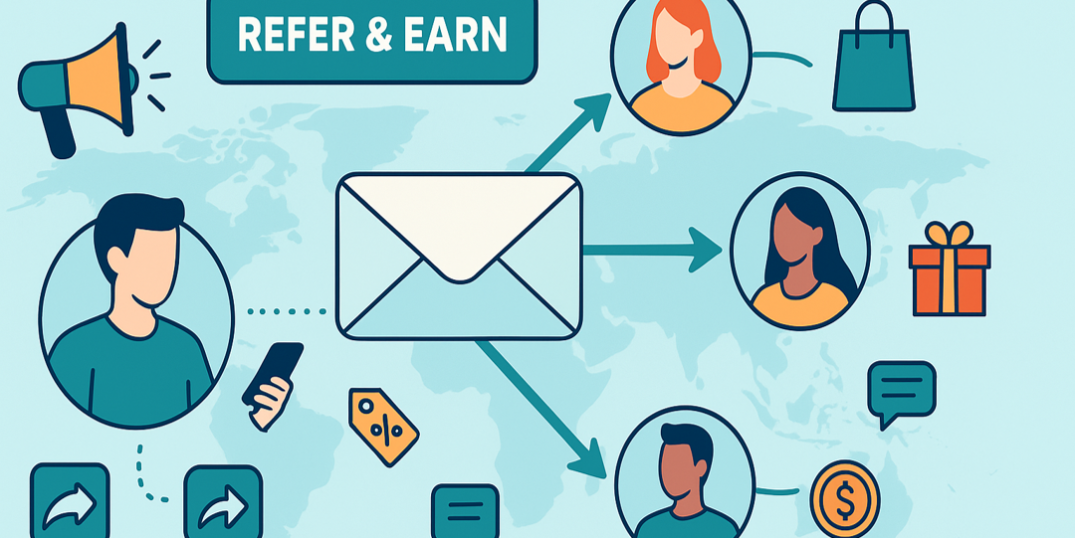- Home
- Fundamentals of Email Marketing
- Referral Marketing for SaaS an ...

There’s something genuine about the way people talk about things they love. Just one person saying to another, “You should try this.” This simple sentence explains, nonetheless, well enough the essence of referral marketing and why it still works in our over-digitized world. But unlike casual word-of-mouth, referral marketing doesn’t leave it all up to chance. It gives that natural enthusiasm a system, shape, and a little nudge.
Right now, when customer acquisition costs are climbing and attention spans are shrinking, having your own customers bring in new ones is truly priceless. Also, because it is rooted in something that hasn’t gone out of style: trust.
In this article, we’re going to zoom out a bit. We won’t focus only on email referrals (as powerful as they are). Instead, we’ll look at how to do referral marketing across multiple touchpoints—email, app, social, and even offline. By the time you finish reading, there won’t be any “what is a referral program” confusion left in your head.
What Is Referral Marketing?
Referral marketing is a structured way to turn your happy customers into your most persuasive marketing team—by rewarding them when they bring others in.
To really understand the essence of referral marketing, it helps to think of goodwill as a strategy. If you treat goodwill not just as a pleasant side effect but as something you can intentionally build on, you’ll start to grasp what referral marketing actually is. It’s about designing a referral program that feels easy, obvious, and genuinely worth sharing.
Think of something simple: a unique link, a clear reward, a well-timed ask. Someone shares, someone joins—and everyone wins. The easier you make it for people to talk about your brand, the more likely they are to do just that.
So, what is referral marketing in the bigger picture? It’s not just one campaign or one button at the end of a checkout page. It’s a multi-channel strategy—a flow that can move through emails, in-app prompts, SMS nudges, or even QR codes printed on a thank-you note. It’s not a standalone tactic. It’s a framework that supports your brand’s growth across different touchpoints.
And while referral marketing might sound simple on the surface, it’s not as easy as it looks. The reason? You can’t fake sincerity. People only share what they truly love. That’s why your referral campaign has to feel honest—not scripted, not transactional, but aligned with what your users actually value. Your job isn’t to force it. Your job is to make that sharing feel natural, meaningful, and easy to act on.
Most popular referral methods
How Referral Marketing Works
While referral requests can sometimes look like just a kind question or a gentle nudge, they’re never random. A good referral marketing campaign is always intentional. It has a clear structure and distinct components that, when combined, create a powerful flow:
👉 A trigger (a purchase, a positive review, a milestone).
👉 A sharing mechanism (link, button, code).
👉 An incentive (for the sender, the receiver, or both).
👉 A conversion (someone signs up, buys, or activates).
It’s not complicated. Quite the opposite—it’s clear, straightforward, and even elegant. That’s exactly where its strength lies.
In practice, though, these flows can take many different forms. A SaaS tool might display a referral modal right after a user completes onboarding. An e-commerce site could send out a referral code as soon as a customer leaves a great review. Some brands follow up with a friendly reminder—“Know someone who’d love this too?” Others simply weave the referral option into their navigation or loyalty dashboard.
Whichever route you choose, the key is to make it feel natural—not like an interruption. It should be integrated into the customer’s experience, not added on top of it.
The same applies to incentives. You’ve got plenty of options: cash rewards, discounts, store credit, loyalty points, early access, even exclusive features. The list is impressive—and the right choice depends on your brand, your tone, your product, and your industry. You definitely have something to offer—the trick is to align that reward with your specific context.
Finally, the structure of the reward matters too. In a one-sided referral program, only the referrer gets the reward. In a two-sided program, both the sender and the receiver benefit. And as you’ve probably guessed, two-sided referral programs tend to convert better. Why? Because generosity scales. People like to feel they’re giving something—not just getting it.
As mentioned earlier, every incentive depends on your particular audience, your brand, and the way you communicate. But one thing always matters: the value should be clear, and the action should be easy.

Referral Marketing Channels (Beyond Email)
Email might be the first channel we think of for referrals—and it’s still incredibly effective, no argument here! But referral marketing is no longer tied to inboxes alone. In fact, it never was. Today, it’s everywhere your customers are:
🔹 In-app referrals
In-app referrals, especially in SaaS and mobile apps, are the smoothest way to catch users mid-experience. If someone’s getting value out of your product, asking them to share at that moment might feel very natural. Examples of what might work here: a referral banner after completing a task or a reward pop-up after hitting a milestone.
🔹 Social sharing & messaging apps
Platforms like WhatsApp, Messenger, and SMS can significantly boost referrals. Why? Because messengers are personal. If a user can send a link directly in a chat where they’re already talking to a friend, the conversion potential rises. Many referral marketing campaigns now include pre-written messages for easy sharing.
🔹 Dedicated referral landing pages
Sometimes, the simplest way is the best way. A clean landing page with a custom referral link, a visual reward summary, and a few quick FAQs can do wonders. These pages are easy to link in emails, in-app banners, or ads. They give users one central place to refer, track rewards, and learn more.
🔹 Affiliate-style links for power users
Some of your most loyal customers might want a little more structure and/or visibility. Offering them a branded referral dashboard or affiliate-style tracking can be a way to turn casual sharers into your brand’s preachers. This approach is great for superusers, influencers, or community leaders.
🔹 QR codes in physical spaces
Great news is that referral marketing isn’t just digital. For e-commerce brands with packaging or SaaS companies attending events, QR codes can connect offline moments with online conversions. “Loved this? Scan & share—and earn something sweet.” Simple, catchy, and working!

Referral Marketing for SaaS vs. E-Commerce
The principles of referral marketing are universal, yet they’re not identical. How they show up depends on your type of business and your business model.
For SaaS companies, the main referral action often happens inside the product. How does that look? When users complete onboarding, unlock a feature, or reach a milestone—that’s your opportunity window. It’s the moment when it makes sense to capitalize on their feeling of novelty or success and offer a gentle nudge, like, “You’ve built your first campaign—want to share the love?”
Incentives here usually take the form of free trial extensions, extra credits, or unlocked features. And considering the nature of SaaS products, these are perfect—they keep users in the product longer while also helping spread the word.
For e-commerce, the situation is quite different. In this type of business, the sweet referral spot is right after a purchase or delivery. That’s the moment when the customer is most delighted or excited. And it’s the best time to ask for a referral because they’ve just experienced the product—and ideally, they’re happy with it.
Incentives here tend to be more tangible: discounts, loyalty points, free samples, or even full products. A classic example is “Give 10%, Get 10%.” It works great—especially when someone is still thrilled about what they’ve just unwrapped.
The role of the customer journey
It is important to mention one more thing—the customer journey. The way people interact with your brand, how long it takes them to make a decision, how emotionally involved they are, how quickly they experience value—all of that shapes how and when it makes sense to ask for a referral. And since customer journeys can look very different depending on the industry, your referral approach needs to adapt too.
The customer journey in SaaS is usually longer and more gradual. People go through setup, onboarding, learning how the tool works, and then finally reaching the “aha” moment. That’s why timing matters so much here—you don’t want to push for referrals too early. You want to wait until the user has actually experienced value. So, in SaaS, referral marketing needs to be carefully timed and feel like a part of the product experience.
On the contrary, when it comes to the customer journey in e-commerce, it’s usually much faster and more emotional. Someone sees something they like, makes a decision quickly, and the excitement peaks when the order arrives. That’s your referral window. It’s a much shorter cycle, and the referral ask has to ride that emotional wave. So, for e-commerce, referral marketing works best when it feels like a natural extension of post-purchase happiness.
Tips on How to Create a Referral Marketing Strategy
1️⃣ Identify ways to incentivize customers
Start by thinking about what would actually feel like a reward to your audience. The main thing is to offer something your customer genuinely values and that makes the act of sharing feel rewarding.
2️⃣ Choose the right marketing software
There’s no need to build everything from scratch. Pick a tool that integrates well with your current setup and makes it easy to create and track referrals across different channels. Whatever it is you decide on, the goal is to make the tech work for you—not the other way around.
3️⃣ Promote your referral program
A referral program won’t work if no one knows it exists. Make it visible: put it in your emails, inside your product, on your thank-you pages, in your chatbots. Just make sure that wherever your customers are, the option to refer is never too far away.
4️⃣ Track, measure, and optimize
Keep an eye on how your referral campaigns perform. If something isn’t working, adjust it—try a different reward, move the CTA, or change the timing. Referral marketing is a living thing, and the more attention you give it, the better it grows.
To Sum Up
Referral marketing is still one of the few strategies that puts people at the center—and turns your happiest customers into your most persuasive marketers.
You can run referrals through email, inside your app, via social media, SMS, landing pages—even QR codes on packaging. The channels can vary, and so can the rewards. But the one thing that doesn’t change is this: if it doesn’t feel genuine, it won’t work. People share what they trust—and what they believe in. So, your job is to make that sharing easy, make the reward worth it, and most of all, stay honest about what you’re asking for.



